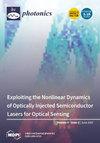Experimental Investigation on the Dynamics Characteristics of a Two-State Quantum Dot Laser under Optical Feedback
IF 2.1
4区 物理与天体物理
Q2 OPTICS
引用次数: 0
Abstract
We experimentally investigate the dynamics characteristics of a two-state quantum dot laser (TSQDL) subject to optical feedback. Firstly, we inspect the impact of the temperature on the power-current characteristics of the ground state (GS) lasing and the excited state (ES) lasing in the TSQDL operating at free-running. The results demonstrate that with the decrease in the temperature, the threshold current for GS lasing (IthGS) and the threshold current for ES lasing (IthES) decrease very slowly. There exists a current for GS quenching (IQGS), which is gradually increased with the decrease in the temperature. After introducing optical feedback, the overall trend of change is similar to those obtained under free-running. Next, through inspecting the time series and power spectrum of the output from the TSQDL under optical feedback, the dynamical characteristics of the TSQDL are investigated under different feedback ratios, and diverse dynamical states including quasi-chaos pulse package, chaos state, regular pulse package, quasi-period two, quasi-regular pulsing, and chaos regular pulse package have been observed. Finally, for the TSQDL biased at three different cases: lower than IthES, slightly higher than IthES, and higher than IthES, nonlinear dynamic state evolutions with the increase in feedback ratio are inspected, respectively. The results show that, for the TSQDL biased at lower than IthES, it presents an evolution route of stable state—quasi-chaos pulse package—chaos state—regular pulse package. For the TSQDL biased at slightly larger than IthES, it presents an evolution route of stable state—quasi-regular pulsing—quasi-period two—chaos regular pulse package. For the TSQDL biased at higher than IthES, the TSQDL always behaves stable state within the range of feedback ratio that the experiment can achieve. However, with the increase in optical feedback ratio, the number of longitudinal modes for GS lasing and ES lasing are changed.光反馈下双态量子点激光器动力学特性的实验研究
我们通过实验研究了受光反馈影响的双态量子点激光器(TSQDL)的动力学特性。首先,我们考察了温度对自由运行的 TSQDL 的基态(GS)激光和激发态(ES)激光的功率-电流特性的影响。结果表明,随着温度的降低,GS 激光的阈值电流(IthGS)和 ES 激光的阈值电流(IthES)下降非常缓慢。GS淬火电流(IQGS)随着温度的降低而逐渐增大。引入光反馈后,总体变化趋势与自由运行时相似。接下来,通过检测光反馈下 TSQDL 输出的时间序列和功率谱,研究了不同反馈比下 TSQDL 的动态特性,观察到了准混沌脉冲包、混沌态、规则脉冲包、准周期二、准规则脉动和混沌规则脉冲包等多种动态状态。最后,针对 TSQDL 在低于 IthES、略高于 IthES 和高于 IthES 三种不同情况下的偏置,分别考察了非线性动态状态随反馈比增加而发生的演变。结果表明,对于偏压低于 IthES 的 TSQDL,它呈现出稳定状态-类混沌脉冲包-混沌状态-规则脉冲包的演化路线。对于偏压略大于 IthES 的 TSQDL,它呈现出稳定状态-准不规则脉冲-准周期双混沌不规则脉冲包的演化路线。对于偏压大于 IthES 的 TSQDL,在实验所能达到的反馈比范围内,TSQDL 始终表现为稳定状态。然而,随着光反馈比的增大,GS 激光和 ES 激光的纵向模式数发生了变化。
本文章由计算机程序翻译,如有差异,请以英文原文为准。
求助全文
约1分钟内获得全文
求助全文
来源期刊

Photonics
Physics and Astronomy-Instrumentation
CiteScore
2.60
自引率
20.80%
发文量
817
审稿时长
8 weeks
期刊介绍:
Photonics (ISSN 2304-6732) aims at a fast turn around time for peer-reviewing manuscripts and producing accepted articles. The online-only and open access nature of the journal will allow for a speedy and wide circulation of your research as well as review articles. We aim at establishing Photonics as a leading venue for publishing high impact fundamental research but also applications of optics and photonics. The journal particularly welcomes both theoretical (simulation) and experimental research. Our aim is to encourage scientists to publish their experimental and theoretical results in as much detail as possible. There is no restriction on the length of the papers. The full experimental details must be provided so that the results can be reproduced. Electronic files and software regarding the full details of the calculation and experimental procedure, if unable to be published in a normal way, can be deposited as supplementary material.
 求助内容:
求助内容: 应助结果提醒方式:
应助结果提醒方式:


